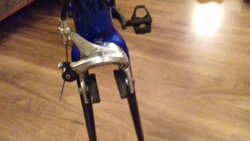Hi there
I was out cycling last night and got a puncture on the way home on the front wheel of my Giant road bike. The tyres I have are Continental Gatorskin Hardshell. I'm not very good at fixing things and I've only ever fixed a puncture once before, so I'm looking for some advice. Is this what I should be doing:
Check the wheel (the part that the inner tube sits on) for any debris (thorns, shards of glass, etc) and also do the same for the inside, side and outside of the tyre. Put a bit of air into the new inner tube (just enough to give it some shape), then put the valve inside the hole, put the inner tube on and work the tyre round being very careful not to pinch - is this correct.
Also (see enclosed picture) - I've pulled up the wee black lever thingy (in pic) to release the brakes to get the tyre out - is that all I need to do here or should I be doing something else? It looks as if the flat tyre was able to come out from between the brake blocks but it certainly doesn't look like a fully inflated tyre would be able to fit back in - hence the reason I'm asking if there is something else I should be doing.
Thanks everyone in advance for your help.
I was out cycling last night and got a puncture on the way home on the front wheel of my Giant road bike. The tyres I have are Continental Gatorskin Hardshell. I'm not very good at fixing things and I've only ever fixed a puncture once before, so I'm looking for some advice. Is this what I should be doing:
Check the wheel (the part that the inner tube sits on) for any debris (thorns, shards of glass, etc) and also do the same for the inside, side and outside of the tyre. Put a bit of air into the new inner tube (just enough to give it some shape), then put the valve inside the hole, put the inner tube on and work the tyre round being very careful not to pinch - is this correct.
Also (see enclosed picture) - I've pulled up the wee black lever thingy (in pic) to release the brakes to get the tyre out - is that all I need to do here or should I be doing something else? It looks as if the flat tyre was able to come out from between the brake blocks but it certainly doesn't look like a fully inflated tyre would be able to fit back in - hence the reason I'm asking if there is something else I should be doing.
Thanks everyone in advance for your help.
Attachments
Last edited:


